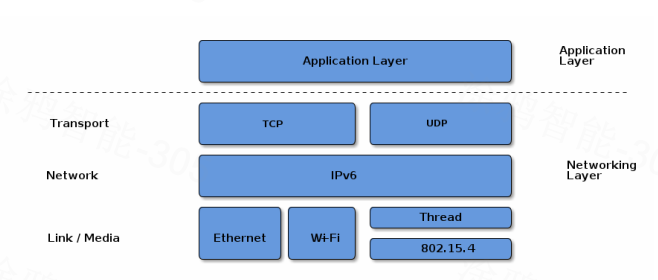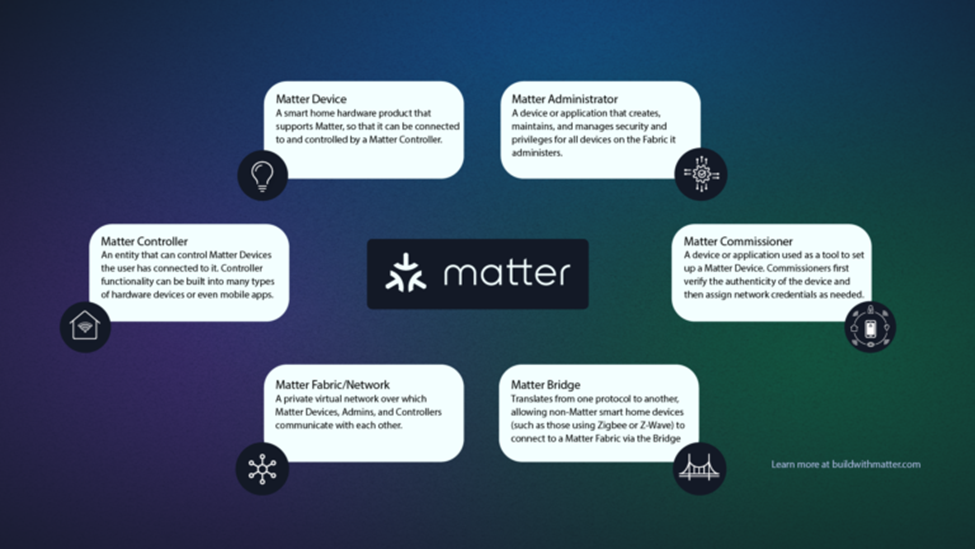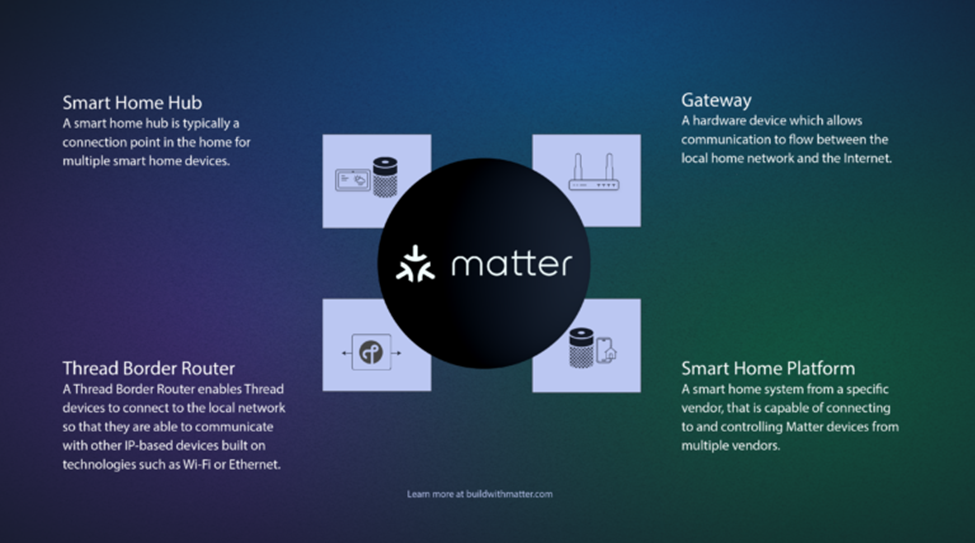Matter Overview
Last Updated on : 2024-06-25 03:36:41download
This topic provides an overview of the Matter standard, including its definitions, components, networking roles, and terms.
What is Matter
Matter (formerly Project Connected Home over IP or Project CHIP) is a unifying, IP-based connectivity protocol built on proven technologies, aiming to create a unified communication standard across smart home devices, mobile applications, and cloud services.

Matter is an industry-unifying standard that promises reliable, secure, seamless, and future-proof device connectivity. It is a local IPv6 wireless connectivity technology designed to enable interoperability between devices made by different manufacturers. Working with existing Wi-Fi and Thread protocols, Matter establishes a standard setup process and certification program, ensuring a frustration-free experience for users.
In principle, any IPv6-bearing network is suitable for Matter deployment, subject to supporting a few core IPv6 standards. The current version of the specification focuses on three link layer technologies:
- Matter over Wi-Fi
- Matter over Thread
- Matter over Ethernet
Non-Matter devices, such as those using Zigbee, Bluetooth mesh, and Sub-GHz, can be connected to a Matter fabric over the Matter bridge.
Building blocks of Matter

Matter device
A smart home hardware product that supports Matter can be connected to and controlled by a Matter controller. For example, light bulbs, switches, sensors, thermostats, blinds, door locks, bridges, and media devices.
Matter fabric
Matter devices are connected together on a virtual network within the home called a Matter fabric, a private virtual network over which Matter devices, admins, and controllers communicate with each other. Matter fabrics can span across the Wi-Fi, Thread, and Ethernet physical networks within the home. Matter devices can be connected to one or more fabrics at a time, each managed by a Matter administrator. Matter fabrics are sometimes referred to as services by smart home apps and platforms.
Matter commissioner
A device or application that is used as a tool to set up a Matter device to bring it onto a Matter fabric. Commissioners first verify the device’s authenticity and then assign network credentials as needed. A platform, device vendor, or other Matter-enabled app, mobile OS, smart speaker, or display can function as a Matter commissioner. A commissioner can be an independent tool or part of a device or system that includes other roles, such as administrator or controller.
Matter administrator
A device or application that creates, maintains, and manages security and privileges for all devices on the fabric it administers. Administrators can be a physical device like a hub or software like an app. Matter’s multi-admin feature enables devices to connect to multiple Matter administrators and thus to multiple fabrics simultaneously, which is multiple smart home platforms.
Matter controller
As the name suggests, a Matter controller is an entity that can control the connected Matter devices. Matter controller functionality can be built into many types of hardware devices such as mobile phones, mains-powered smart home hubs that provide local and remote control, smart switches and panels, or even mobile apps. There can be multiple Matter controllers on a fabric to provide redundancy and/or convenient controls for users. In most cases, a Matter controller is exclusive to the company that provides it. For example, a smart speaker with a Matter controller from Smart Home Platform A can be used to control Matter devices through the Platform A app, voice control, or other interfaces. But if users want to use Platform B to control Matter devices, they will need to have one of Platform B’s controllers. An exception to this is devices such as switches, buttons, and sensors that can be commissioned as third-party controllers on a Fabric.
With Matter’s multi-admin features, users can connect Matter devices to multiple platforms if they have a Matter controller for each platform in the home. Matter controller is the technical term for this role. Many smart home platforms colloquially refer to their devices that contain Matter controllers as hubs.
Matter bridge
A Matter bridge translates from one protocol to another, allowing non-Matter smart home devices (such as those using Zigbee or Z-Wave) to connect to a Matter fabric via the bridge. This allows consumers to use their non-Matter smart home devices along with their new Matter devices to continue growing their unified smart home. A Matter bridge is a different role than a controller. A bridge serves as an intermediary for Matter and non-Matter devices. However, Bridges can be built into a number of devices like smart home hubs that also serve as Matter controllers.
In most cases, a smart home product can act in different roles, even simultaneously.
Related networking roles and terms
Other common network components in smart homes and related terms are listed below. Although the below devices and roles are not defined by the Matter specification, they are key components of the networks Matter runs over, and are often featured in discussions of Matter.

Smart home platform
A smart home system from a specific vendor, which is capable of connecting to and controlling Matter devices from multiple vendors. Amazon Alexa, Apple Home, Google Home, Samsung SmartThings, and Tuya Smart, are all examples of smart home platforms.
Smart home hub
A smart home hub is typically a connection point in the home for multiple smart home devices. It is usually specific to the vendor that provides it and can contain multiple connectivity technologies in order to support various devices. Many smart home hubs are now Matter-supported. They act as a Matter administrator and controller, and sometimes a commissioner or bridge. Hubs may offer additional functionality, such as locally processing automations or providing device control via voice or a display.
Gateway
A hardware device that allows communication to flow between the local home network and the internet, for example, Wi-Fi routers and access points.
Thread border router
A Thread border router enables Thread devices to connect to the local network so that they can talk to other IP-based devices built on technologies such as Wi-Fi or Ethernet. Thread border routers can be built into existing products, such as Wi-Fi access points, smart speakers, hubs, and more.
Is this page helpful?
YesFeedbackIs this page helpful?
YesFeedback





